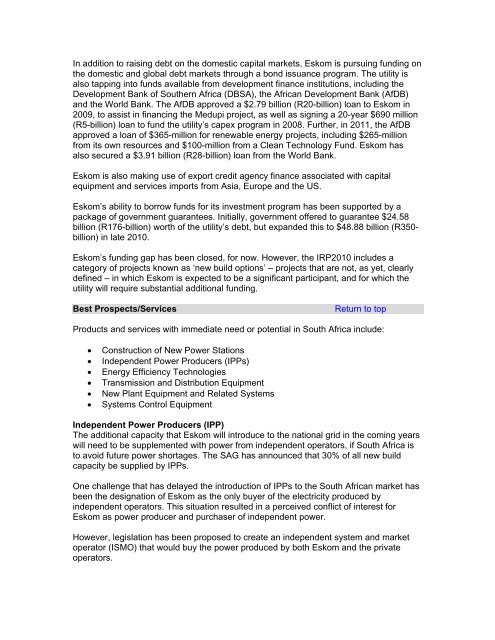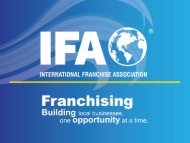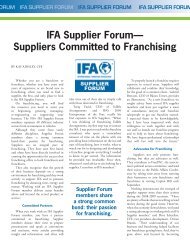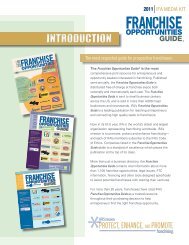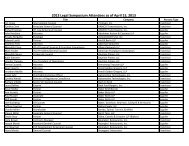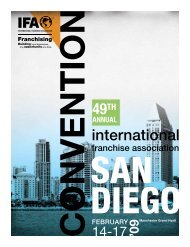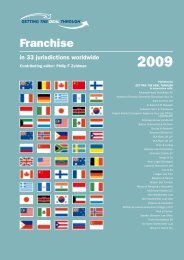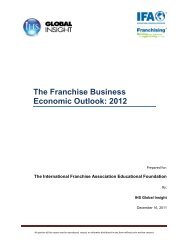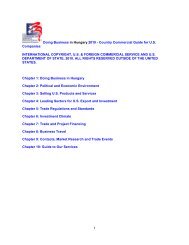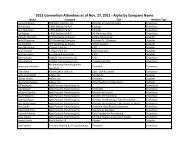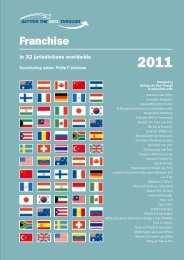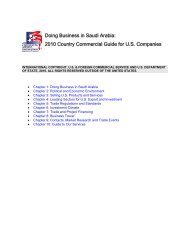South Africa - International Franchise Association
South Africa - International Franchise Association
South Africa - International Franchise Association
Create successful ePaper yourself
Turn your PDF publications into a flip-book with our unique Google optimized e-Paper software.
In addition to raising debt on the domestic capital markets, Eskom is pursuing funding on<br />
the domestic and global debt markets through a bond issuance program. The utility is<br />
also tapping into funds available from development finance institutions, including the<br />
Development Bank of <strong>South</strong>ern <strong>Africa</strong> (DBSA), the <strong>Africa</strong>n Development Bank (AfDB)<br />
and the World Bank. The AfDB approved a $2.79 billion (R20-billion) loan to Eskom in<br />
2009, to assist in financing the Medupi project, as well as signing a 20-year $690 million<br />
(R5-billion) loan to fund the utility’s capex program in 2008. Further, in 2011, the AfDB<br />
approved a loan of $365-million for renewable energy projects, including $265-million<br />
from its own resources and $100-million from a Clean Technology Fund. Eskom has<br />
also secured a $3.91 billion (R28-billion) loan from the World Bank.<br />
Eskom is also making use of export credit agency finance associated with capital<br />
equipment and services imports from Asia, Europe and the US.<br />
Eskom’s ability to borrow funds for its investment program has been supported by a<br />
package of government guarantees. Initially, government offered to guarantee $24.58<br />
billion (R176-billion) worth of the utility’s debt, but expanded this to $48.88 billion (R350billion)<br />
in late 2010.<br />
Eskom’s funding gap has been closed, for now. However, the IRP2010 includes a<br />
category of projects known as ‘new build options’ – projects that are not, as yet, clearly<br />
defined – in which Eskom is expected to be a significant participant, and for which the<br />
utility will require substantial additional funding.<br />
Best Prospects/Services Return to top<br />
Products and services with immediate need or potential in <strong>South</strong> <strong>Africa</strong> include:<br />
• Construction of New Power Stations<br />
• Independent Power Producers (IPPs)<br />
• Energy Efficiency Technologies<br />
• Transmission and Distribution Equipment<br />
• New Plant Equipment and Related Systems<br />
• Systems Control Equipment<br />
Independent Power Producers (IPP)<br />
The additional capacity that Eskom will introduce to the national grid in the coming years<br />
will need to be supplemented with power from independent operators, if <strong>South</strong> <strong>Africa</strong> is<br />
to avoid future power shortages. The SAG has announced that 30% of all new build<br />
capacity be supplied by IPPs.<br />
One challenge that has delayed the introduction of IPPs to the <strong>South</strong> <strong>Africa</strong>n market has<br />
been the designation of Eskom as the only buyer of the electricity produced by<br />
independent operators. This situation resulted in a perceived conflict of interest for<br />
Eskom as power producer and purchaser of independent power.<br />
However, legislation has been proposed to create an independent system and market<br />
operator (ISMO) that would buy the power produced by both Eskom and the private<br />
operators.


